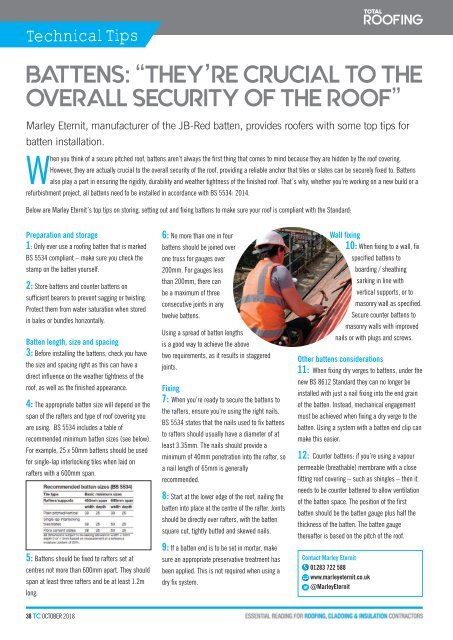October 2018
Create successful ePaper yourself
Turn your PDF publications into a flip-book with our unique Google optimized e-Paper software.
Technical Tips<br />
BATTENS: “THEY’RE CRUCIAL TO THE<br />
OVERALL SECURITY OF THE ROOF”<br />
Marley Eternit, manufacturer of the JB-Red batten, provides roofers with some top tips for<br />
batten installation.<br />
When you think of a secure pitched roof, battens aren’t always the first thing that comes to mind because they are hidden by the roof covering.<br />
However, they are actually crucial to the overall security of the roof, providing a reliable anchor that tiles or slates can be securely fixed to. Battens<br />
also play a part in ensuring the rigidity, durability and weather tightness of the finished roof. That’s why, whether you’re working on a new build or a<br />
refurbishment project, all battens need to be installed in accordance with BS 5534: 2014.<br />
Below are Marley Eternit’s top tips on storing, setting out and fixing battens to make sure your roof is compliant with the Standard:<br />
Preparation and storage<br />
1: Only ever use a roofing batten that is marked<br />
BS 5534 compliant – make sure you check the<br />
stamp on the batten yourself.<br />
2: Store battens and counter battens on<br />
sufficient bearers to prevent sagging or twisting.<br />
Protect them from water saturation when stored<br />
in bales or bundles horizontally.<br />
Batten length, size and spacing<br />
3: Before installing the battens, check you have<br />
the size and spacing right as this can have a<br />
direct influence on the weather tightness of the<br />
roof, as well as the finished appearance.<br />
4: The appropriate batten size will depend on the<br />
span of the rafters and type of roof covering you<br />
are using. BS 5534 includes a table of<br />
recommended minimum batten sizes (see below).<br />
For example, 25 x 50mm battens should be used<br />
for single-lap interlocking tiles when laid on<br />
rafters with a 600mm span.<br />
5: Battens should be fixed to rafters set at<br />
centres not more than 600mm apart. They should<br />
span at least three rafters and be at least 1.2m<br />
long.<br />
6: No more than one in four<br />
battens should be joined over<br />
one truss for gauges over<br />
200mm. For gauges less<br />
than 200mm, there can<br />
be a maximum of three<br />
consecutive joints in any<br />
twelve battens.<br />
Using a spread of batten lengths<br />
is a good way to achieve the above<br />
two requirements, as it results in staggered<br />
joints.<br />
Fixing<br />
7: When you’re ready to secure the battens to<br />
the rafters, ensure you’re using the right nails.<br />
BS 5534 states that the nails used to fix battens<br />
to rafters should usually have a diameter of at<br />
least 3.35mm. The nails should provide a<br />
minimum of 40mm penetration into the rafter, so<br />
a nail length of 65mm is generally<br />
recommended.<br />
8: Start at the lower edge of the roof, nailing the<br />
batten into place at the centre of the rafter. Joints<br />
should be directly over rafters, with the batten<br />
square cut, tightly butted and skewed nails.<br />
9: If a batten end is to be set in mortar, make<br />
sure an appropriate preservative treatment has<br />
been applied. This is not required when using a<br />
dry fix system.<br />
Wall fixing<br />
10: When fixing to a wall, fix<br />
specified battens to<br />
boarding / sheathing<br />
sarking in line with<br />
vertical supports, or to<br />
masonry wall as specified.<br />
Secure counter battens to<br />
masonry walls with improved<br />
nails or with plugs and screws.<br />
Other battens considerations<br />
11: When fixing dry verges to battens, under the<br />
new BS 8612 Standard they can no longer be<br />
installed with just a nail fixing into the end grain<br />
of the batten. Instead, mechanical engagement<br />
must be achieved when fixing a dry verge to the<br />
batten. Using a system with a batten end clip can<br />
make this easier.<br />
12: Counter battens: if you’re using a vapour<br />
permeable (breathable) membrane with a close<br />
fitting roof covering – such as shingles – then it<br />
needs to be counter battened to allow ventilation<br />
of the batten space. The position of the first<br />
batten should be the batten gauge plus half the<br />
thickness of the batten. The batten gauge<br />
thereafter is based on the pitch of the roof.<br />
Contact Marley Eternit<br />
01283 722 588<br />
www.marleyeternit.co.uk<br />
@MarleyEternit<br />
38 TC OCTOBER <strong>2018</strong>

















